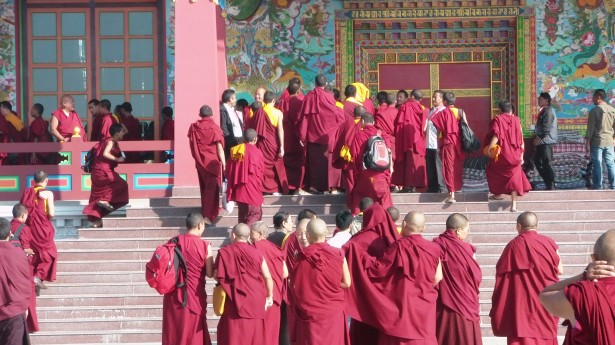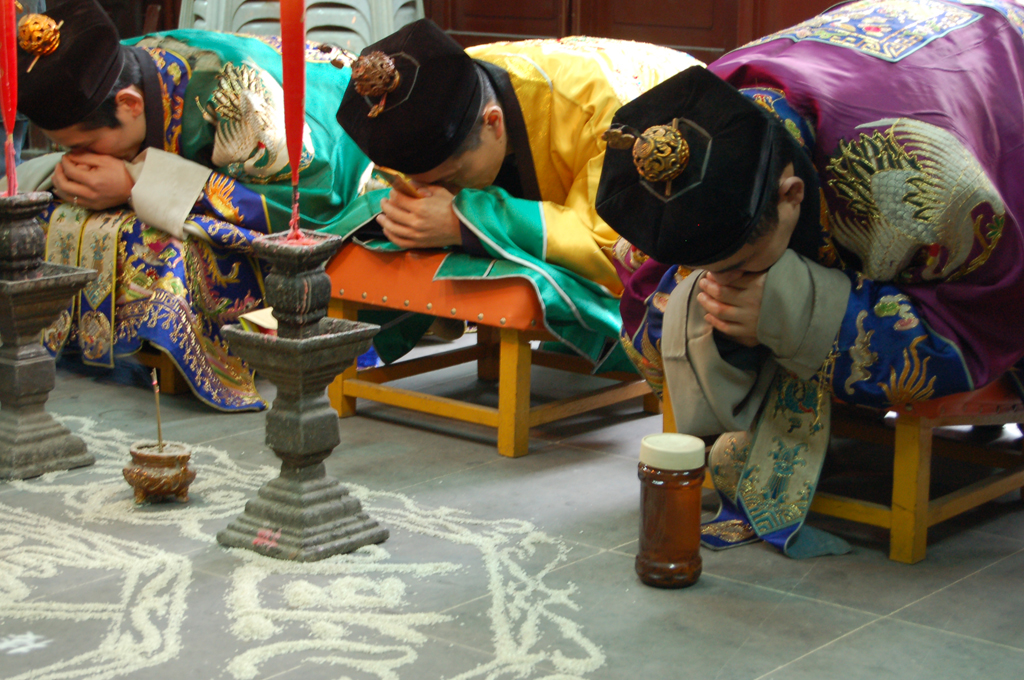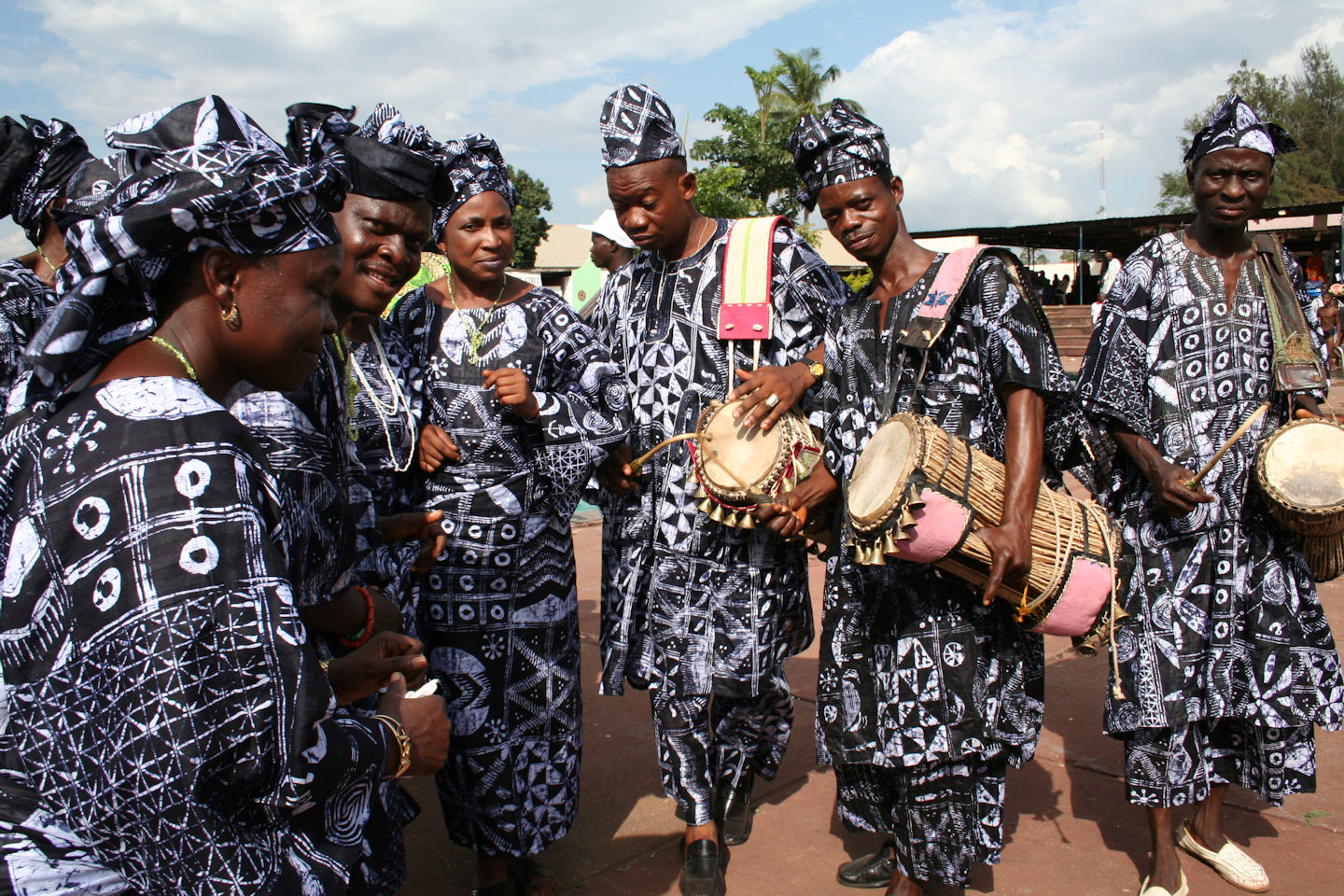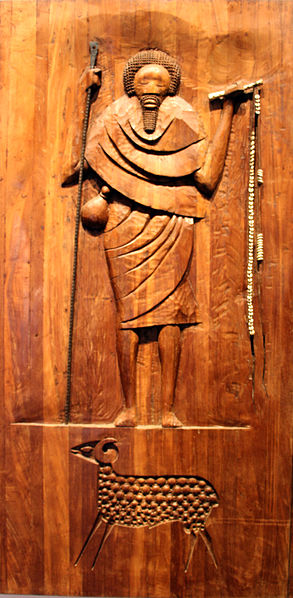6.6 The Philosophy of Other Religions
LEARNING OBJECTIVES
By the end of this section you will discover:
- How religious understandings about the Divine differ in other cultures.
- An argument for why the “philosophy of religion” needs to accommodate these differences.
So far in this chapter we have been discussing philosophical problems emerging from Western monotheistic claims about god. In the following excerpt, we explore the philosophy of religion as it approaches other religious traditions.
Excerpts from Timothy D. Knepper: From Philosophy of (Mono)theism to Philosophy of Religions
In what follows:
How similar is Hindu thought about God to Western Thought? Are there important differences?
So far, I have sketched the genealogy of the philosophy of religion in the Enlightenment or Western or (mono)theistic tradition. My point is simply this: this philosophy of religion is not somehow natural or essential but rather is a product of the contexts and interests of the European Enlightenment and the Western Academy. In this next section, we will take a quick tour of some philosophies of religion “elsewhere” to show that the (mono)theistic model of the philosophy of religion not only misfits but also distorts it. Given space restrictions, this tour will be quick and will cover only four regions: South Asia (India), East Asia (China), West Africa (Yorubaland), and North America (Lakota).
Of these four regions, South Asian philosophy of religion is most similar to (mono)theistic philosophy of religion, in part because there are (mono)theistic conceptions of God in South Asia. Of course, there are other conceptions of God there too. Of the six schools of “orthodox” (āstika) “Hindu” philosophy, the Vedānta school is renowned for its debate concerning the nature of ultimate reality (Brahman) and its relationship to the rest of the cosmos, especially the innermost soul (Ātman). For the “non-dual” (Advaita) Vedānta of Śaṅkara (ca.788-ca.820), everything just is Brahman, which is without or beyond all attributes (nirguṇa), including ones analogized from humans (e.g., having power, having knowledge, being good, creating). Everything that appears to be individualized is therefore just an illusion (māyā). By contrast, the “qualified non-dual” (Vishishtadvaita) Vedānta of Rāmānuja (1017-1137) holds that although Brahman is everything, the world and souls emerge from Brahman and exist separately from Brahman before returning back to Brahman. This Brahman too is ultimately without or beyond attributes. Finally, the “dual” (Dvaita) Vedānta of Madhva (1238-1317) maintains that Brahman (who is in this case person-like), Ātman, and the world are entirely and eternally different substances.
In the case of the other five āstika schools (and elsewhere in “Hindu” thought), conceptions of ultimate reality run the gamut from “there is no such thing,” to “it really doesn’t matter,” to “it is a person-like deity,” to “it is an impersonal reality,” to “it is many different deities or substances.” Despite this variety of positions, however, there just isn’t the kind of obsession with proving that “God” exists or determining “God’s” attributes that there is in (mono)theistic philosophy of religion. Much more important is learning who you are, so you can cut the ties of karma (law of moral cause and effect) that bind you to the wheel of rebirth (saṃsāra).

In addition to these six āstika schools, there are nāstika or “unorthodox” schools such as Buddhism and Jainism that do not accept the authority of the Vedas, the sacred scripture of “Hinduism.” In the case of Buddhism, there is neither an ultimate reality (Brahman) nor an eternal soul (Ātman); and in the case of Jainism, although there are eternal souls (jivas), there is no God in the sense of a first cause of the cosmos. Once again, however, I want to emphasize that the philosophical-debating tradition (vāda) in India is not limited to the topics of ultimate reality and eternal soul—just as important are issues like the nature and means of enlightenment, the nature and mechanics of causation, and the nature and expression of reality. So, although we have a partial fit to the God of Christian (mono)theism, few if any of the topics and questions of Christian-(mono)theistic philosophy of religion are present in South Asian philosophy of religion.

In China, by contrast, none of the influential “three teachings” … hold person-like views of ultimate reality: for Confucians, Tian (天), which can be translated as heaven or nature, is generally thought of as impersonal; for Daoists, Dao (道) is an impersonal cosmic source and force by which all things are balanced in continual change; and for (some) Buddhists, Buddha-nature (佛性) is the originally enlightened nature of humans and dynamic harmony of all things. The chief philosophical questions, though, do not generally concern the nature of these “ultimate realities” but rather the means by which society, nature, and the mind can be harmonized. In fact, Confucianism and Daoism have their origins during a time of social chaos and strife known as the “Warring States” period (403-221 BCE). Confucius (551-479 BCE) taught a way to bring harmony and flourishing to the self and society both by expressing our human-heartedness (ren, 仁) in social rituals and behaviors (li, 禮) and by ordering society according to five basic kinds of relationships: father/son, elder-brother/younger-brother, husband/wife, elder/younger, and ruler/subject. One classical Daoist text, the Daodejing, by contrast, advised human beings in general and rulers, in particular, to act in a manner that is as spontaneous, natural, and effortless as possible, while another classical Daoist text, the Zhuangzi, was unconcerned with, if not antagonistic toward, political rule, focusing instead on the sage who could rise above it all, so to speak. Here, then, we have a near, if not complete, misfit with the questions and topics of Christian-(mono)theistic philosophy of religion due to the fact that no such God is at issue in East Asian philosophy of religion.

One of the more notable and widespread African religions is the West African religion of Yorùbá, which originates and is still practiced in the “Yorubaland” region of Nigeria, Benin, Togo, and Ghana. Yorùbá religious thought and practice is so widespread because the Yorùbá not only is one of the largest ethnic groups in all of Africa but also, sadly, were the most enslaved ethnic group from all of Africa. As a result, there are significant Yorùbá populations in many Central and South American countries, and Yorùbá religious thought and practice are present in several New World religions like Santeria in Cuba, Vodou in Haiti, and Candomble in Brazil.

Like many indigenous religions of Africa, Yorùbá is unlike Christian (mono)theism. There is not one God, but many deities called Òrìṣà, which are invoked by humans through the help of priests to remediate suffering and misfortune as well as to secure safety and blessing. According to Yorùbá scripture—a divinatory corpus called Ifá—there are 400 primordial Òrìṣà, which are locked in eternal combat with 200 primordial “anti-gods” called ajogun. However, since new Òrìṣà and ajogun have been added since the creation of the world (and continue to be added), their numbers are represented by 400+1 and 200+1, respectively, where the “1” is the set of all newly created entities. Although the Yorùbá do think of one deity as a “high god,” Olódùmarè is just one of four deities to carry out the creation of the cosmos. Moreover, Olódùmarè plays little role in the practice of Yorùbá, which involves contracting a divinatory priest to learn the inner destiny that was given at birth (so as to navigate misfortune and illness during life). So, although the concept of Olódùmarè makes it conceivable that Yorùbá philosophers of religion could ask about his attributes and proofs, they don’t. It’s just not of any concern to them.

Finally, we turn to one of the indigenous American tribes of North America—the Lakota of the North American plains.[16] The Lakota are one tribe or subgroup of the Titonwan, which is also composed of the Dakota and Nakota tribes. For many Euro-Americans, especially during the 19th century, the Lakota (along with the Dakota and Nakota) were known as “Sioux”; this is in fact a pejorative name, meaning “snakes in the grass,” which was given to the Lakota by their Algonquian-speaking neighbors to the east. Although the Lakota were originally granted the entire western portion of South Dakota by the United States government in the 1868 Treaty of Fort Laramie, this Treaty was reneged after gold was discovered in the Black Hills (which are sacred to the Lakota). Now, the Lakota mostly live on reservations in western South Dakota (none of which are in the Black Hills). As in the case of Yorùbá philosophy of religion, pre-colonial Lakota traditions of philosophizing about religion involved a special class of individuals—in this case, the “holy man” or “medicine man” (wicasa wakan). Holy men receive revelations, perform miracles, and otherwise communicate with the spiritual world through dreams and visions. This spiritual world comprises the creative force of Wakan Tanka, which means something like great incomprehensibility, great mystery, or great sacred. Although Wakan Tanka begins to resemble the Christian God after colonization, it apparently first referred to the sum total of sixteen sacred mysterious forces. As in the case of the Yorùbá God, Olódùmarè, we could conceivably conduct philosophical investigations about the attributes and proofs of Wakan Tanka (especially as Wakan Tanka gets Christianized), but that would be simply to redouble the colonial appropriation of Native American culture and thought.
Toward a Philosophy of Religions
How well do the questions and categories of (mono)theistic philosophy of religion apply to these philosophies of religion “elsewhere”? How does a Hindu, Buddhist, Jain, Confucian, Daoist, Yorùbá, or Lakota philosophize about the attributes of God, proofs for the existence of God, or the problem of evil for an omnipotent and omnibenevolent God? Not well, because these “other” philosophies of religion just aren’t very concerned with these questions. In most cases, there isn’t the kind of God that there is in Christian (mono)theism, so these questions make no sense. And in cases where there is something like the kind of God that there is in Christian (mono)theism, philosophical questions about this God’s attributes and proofs have no importance (not even to the philosophers from these traditions). What happens, then, when we force them to play by the rules (categories) of (mono)theistic philosophy of religion? They appear deficient or strange or wrong.
I, therefore, contend that if the philosophy of religion is to be the philosophy of religions and not just the philosophy of (mono)theism, it must be rethought from the ground up, not merely expanded or enlarged. … In particular, I propose drawing on the component parts of the journey metaphor, which is not only allegedly fundamental to cognition and culturally widespread but also actually utilized in many different religious traditions to metaphorically structure religious growth and maturation.
By the journey metaphor, I mean, more exactly, the metaphor life is a journey, which utilizes the conceptual structure of a journey to understand and express the temporal dimension of people’s lives. Although there is much to say about this metaphor, I will here stick to its core, constituent parts: journeys have a point of origin and destination, a route that is planned, obstacles and sights that are encountered along the way, and a traveler who is accompanied by and encounters other travelers. Of course, these constituent parts are not themselves philosophical questions or topics; nevertheless, they can be used to generate such questions or topics, five of which are important and productive for a global philosophy of religions:
-
- Who am I?
- Where do I come from?
- Where am I going?
- How do I get there?
- What obstacles lie in my way?
Several comments are in order about these questions. First, each question is purposefully vague, requiring specification by means of the precise content of some religious philosophy; for example, the “I” might be understood as an individual, a certain group of people, human beings in general, or nothing at all. Second, these philosophical questions can be answered for a religious philosophy even if it does not portray individual lives as purposeful or draw on the metaphor life is a journey; for example, the questions “where am I going?” and “how do I get there?” might have meaningful answers even if the religious philosophy does not explicitly conceptualize human beings as having destinations and paths. Third, it is not the case that a religious philosophy has to have a positive or explicit answer to the five questions above to have a significant answer to them; for example, a religious philosophy might hold that thinking there is a self that travels some religious path to some other-worldly destination is precisely what needs to be overcome. Finally, an objection might be raised that although the five questions above are important and interesting questions that have been neglected by traditional philosophy of religion, they are also questions that neglect the topics of traditional philosophy of religion. Entirely missing in these five questions are the core problems of Christian-theistic philosophy of religion: the attributes of God, the existence of God, and the problem of evil.
Ponder if you will…
Take one or more of the journey-metaphor questions and attempt to answer it for all of the traditions of philosophizing about religion identified in this chapter. (Do additional research if needed.)
What range of answers do you get? How does this broaden the scope of the philosophy of religion? How does it aid in your own search for meaning, truth, and value with respect to religion?
My solution to this problem of leaving out Christian-(mono)theistic philosophy of religion is, I believe, simple and elegant. I begin by recognizing that in some philosophies of religion the cosmos can be thought of being on a sort of journey, at least in the sense of having an origin, destination, path, and obstacles. I then note that in some philosophies of religion, the crucial relationship is between humans as a microcosm and the cosmos as a macrocosm. Finally, I show how reduplicating the five questions above with regard to the cosmos yields a second set of rich questions for the philosophy of religion:
7. What is the cosmos?
8. Where does the cosmos come from?
9. Where is the cosmos going?
10. How does the cosmos get there?
11. What obstacles lie in the cosmos’ way?
Clearly (7) gives a place for traditional Christian-(mono)theistic philosophy of religion to discuss the existence and attributes of God, (8) and (9) give a place for discussions of redemption and the afterlife, (10) for sin and the Fall, and so on. Again, I hasten to add that the qualifications above also apply to this set of questions: these questions are vague and need to be made precise by concrete religious philosophies, religious philosophies can meaningfully answer or reject these questions, thus rejections of these questions are as important and significant as answers to these questions. Importantly, though, extending this set of questions from just a (mono)theistic God to the cosmos allows all the philosophies of religion to “get in the game.”
With these qualifications in place, I am rather confident that the ten questions above offer a radically new point of departure for the philosophy of religion, one that can be inclusive of the religious traditions of the globe in a manner that does not unduly privilege any one of them. It is now time to put this plan into practice (Knepper in Branson, Ch. 6).
Works Cited
Adewunmi, Ayo. “Ayo Adewunmi – Yoruba Dancers.” Wikimedia Commons, Wikimedia Commons, 10 Oct. 2008, https://commons.wikimedia.org/wiki/File:Ayo_Adewunmi_-_Yoruba_Dancers.jpg. Accessed 12 Apr. 2022.
Berg, Thomas. “Taoists Performing a Rite at the Baiyun Temple of Shanghai.” Wikimedia Commons, Wikimedia Commons, 2006, https://commons.wikimedia.org/wiki/File:Taoists_performing_a_rite_at_the_Baiyun_Temple_of_Shanghai.jpg. Accessed 12 Apr. 2022.
Lissone, Misc. “Monjes Budistas En Un Monasterio.” Needpix.com, Publicdomainpictures.net, https://www.needpix.com/photo/download/1401125/buddhist-buddhism-temple-monastery-gathering-monk-monks-llama-buddhist-monks-at-a-monastery. Accessed 12 Apr. 2022.
Newman, Anita C. “Cody Coe, of Lakota and Northern Ute Descent, Competes in the Men’s Northern Traditional Dance Competition at the 26th Annual Great American Indian Exposition and Pow-Wow in Richmond, Virginia.” Picryl, U.S. Navy, 11 May 2017, https://picryl.com/media/cody-coe-of-lakota-and-northern-ute-descent-competes-in-the-mens-northern-traditional-d51168. Accessed 12 Apr. 2022.
Sailko. “Carybè, Rilievi Degli Orixas, Orixá Oko.” Wikimedia Commons, Wikimedia Commons, 18 Nov. 2013, https://commons.wikimedia.org/wiki/File:Caryb%C3%A8,_rilievi_degli_orixas,_orix%C3%A1_oko.JPG. Accessed 12 Apr. 2022.

